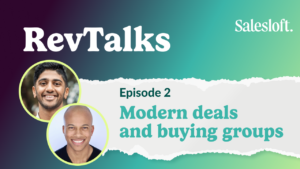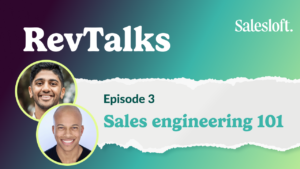If revenue pros are thinking it, we’re saying it. Join us live as go-to-market experts share their best advice and insights from the frontlines of revenue — with tactics you can immediately implement at your organization.
In the very first episode of Salesloft’s RevTalks, veteran sales engineers Chris Turner and Rebby John discuss changes to the sales and presales professionals’ roles, the keys to multithreading ever-expanding buying groups, getting to ROI faster in conversations, the story of “how” in sales, AI, and more.
This interview has been edited for clarity and length.
The sales landscape
Rebby:
Over the last 5 years, how do you think the sales landscape has changed and how do you think that impacts our profession as sales engineers and the sales profession as a whole?
Chris:
There was a time when buyers were less incredulous about the decisions that they were making. Buying committees weren’t as large as they are now. Now sales and transactions are under a microscope. So it’s incumbent upon us as salespeople — and sales engineers specifically —to better educate our buyers, as well as to meet them where they’re at within the buying journey, but then also to be able to come with a perspective that’s strong and help to guide them through this mire of ambiguity that has become the technology landscape.
When I think about sales engineers specifically, the level of our ability to speak to our customers and to solve technical problems and tie that back to the business problem is going to be more and more imperative.
Rebby:
It’s interesting how those changes really have an impact on the profile that you look for as a hiring manager for a sales or a sales engineering role. There’s more of a component of being process-driven in order to manage a complicated buying committee. I think we’ll see the profile for an effective sales and pre-sales professional continue to change.
Chris:
Sales is a decision that’s typically made both in the rational as well as in the technical. The rational side is going to be important. The relationship and the interpersonal is also going to be incredibly important as buyers become even more educated and have more access to technology and answers that they need.
The technical buyer
Chris:
How has the technical buyer changed over the past few years?
Rebby:
First of all, the technical buyer is just more involved in general. It’s important now for sellers to engage the technical buyer earlier rather than later, because we expect that the technical buyer is going to be involved to help make a decision that’s going to be good for an entire company.
A mid-level manager or a department head can’t just put some software on their credit card and enable their team with it anymore. In order to get a deal done, the technical buyer needs to be engaged early because they’ll know how a piece of technology fits into a company’s infrastructure, and how it can drive value for an entire organization versus just one subsection of it.
It’s important for sellers to keep that in mind and focus on bringing the technical buyer in proactively, even when the initial entry point to an account may have been someone that was in the line of business.
Chris:
We need to be able to mirror the customer’s buying committee. The best way that we can do that is proactively, but also having a technical expert on our side to address concerns and be a non biased entity.
Rebby:
It’s honestly such a big part of the sales engineering list of responsibilities:
- To cultivate that relationship with the technical buyer
- To ensure we’re delivering everything that they need to make a really informed technology decision
- To drive value for the end users as well
Chris:
We often talk about the idea of commercial coaching — that we sell way more often than our buyers are buying. And so it’s incumbent on us to be able to help them navigate the internal decision making process. I think there’s probably another layer there about the technical decision making process and technical buying coaching.
The impact of ROI
Chris:
From a technology purchase standpoint, how has increased focus on ROI and expanding buying committees impacted the sales process?
Rebby:
In a down market, the first thing a finance team is going to look at in the way of cost cutting is software. It’s really important for an account team to correlate ROI to adoption. At this point, the market has evolved to a point of maturity where we have a lot of sales teams that are bringing a perspective in every deal cycle as to what the ROI is that the account that they’re trying to sell into will receive from purchasing that product.
But it’s important to make adoption a big part of that ROI story — especially in a competitive landscape where you could have multiple vendors and solutions that could technically fit all of the requirements.
The story of how becomes so much more important.
- How are we going to drive adoption?
- How are we going to ensure that the change management goes off smoothly?
- How are we going to make sure that we’re able to report on the results that a piece of software is driving year over year, quarter over quarter, so it doesn’t sit unused on the shelf?
When making an ROI calculation, it’s so important to include that component of the how.
ROI perspectives
Rebby:
Chris, your team does a lot in terms of putting together ROI perspectives for your accounts. Are you seeing any common themes of how those ROI perspectives are being received by buying teams?
Chris:
Absolutely. I’ve seen examples of what is best in class. And then I’ve also seen examples of what’s not done so well. So I’ll start with the concept of multithreading.
What sellers tend to over-index on is multithreading vertically, or going up to the decision making chain. The C-suite and VP, etc. But especially when you think about ROI and adoption, it’s actually just as important for us to make sure that we’re going wide with our multithreading and getting access to the end users.
A CRO, frankly, isn’t going to be living in whatever platform we’re selling. It’s going to be end users. And so the more we can tell that story of how it’s going to benefit the people using it on a day-to-day, the more compelling that story becomes.
One of my mentors told me that when you are talking to someone in a C-suite, they should be learning something new about their business or in the industry. So, when we are creating an ROI or a business case, we should be telling them something that they don’t already know.
Rebby:
You can’t talk about adoption without talking about the end users. If you have that groundswell with the end users, then it becomes a momentum creating factor in any deal.
AI’s impact on sales
Rebby:
What’s your analysis on how artificial intelligence and automation are going to impact the sales and sales engineering professions?
Chris:
Buyers make decisions from an emotional standpoint as well as from a rational or technical standpoint. And so just like we’re having a conversation here or with our customers, I don’t think we’re ever going to be able to lose that because sales is an inherently human element.
- Our ability to communicate technical requirements and alignment for customers
- Our ability to create a more compelling ROI business case through automation
- Our ability to better coach sellers with data about on buyer interaction
All of those things are going to raise the bar for those human interactions. So instead of us taking away, it’s actually going to make everything better from a 50% or 100% output rate when we think about efficiency, as well as effectiveness within sales cycles and building pipeline.
Rebby:
AI doesn’t replace this. It might be different six months from now, but today AI doesn’t replace the conversation that we’re having right now. To get the big deals across the line that we want, this conversation is never going away.
Check out the rest of the series
You heard that right. We’ve got to keep the conversation going because those human touch points are important all through the buying journey. And with buying committees becoming larger and more complicated, it will surely take some human finesse to make a solution-oriented impact. How will your sales engineers move forward and help your customers buy in this changing sales landscape? The next parts of Chris and Rebby’s conversation can help!
Check out part two where they discuss getting modern deals over the line, or part three to learn their takes on the sales engineering profession. Then subscribe to our YouTube channel to get notified whenever we drop fresh sales engineering videos.
 |
 |


